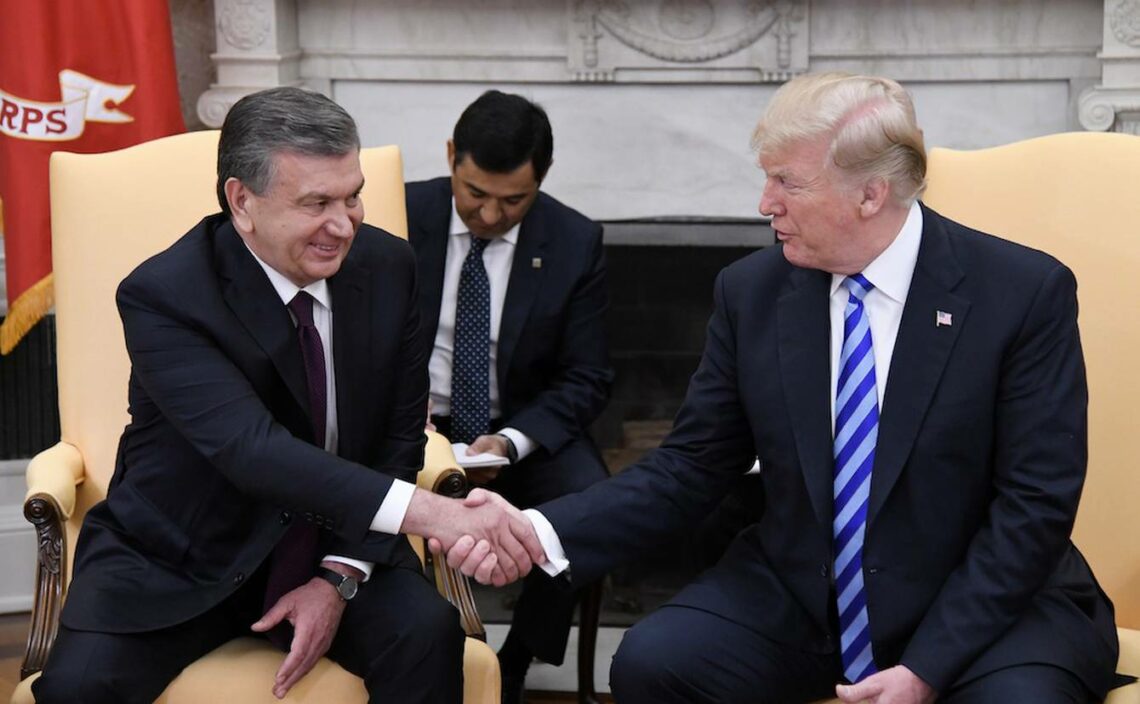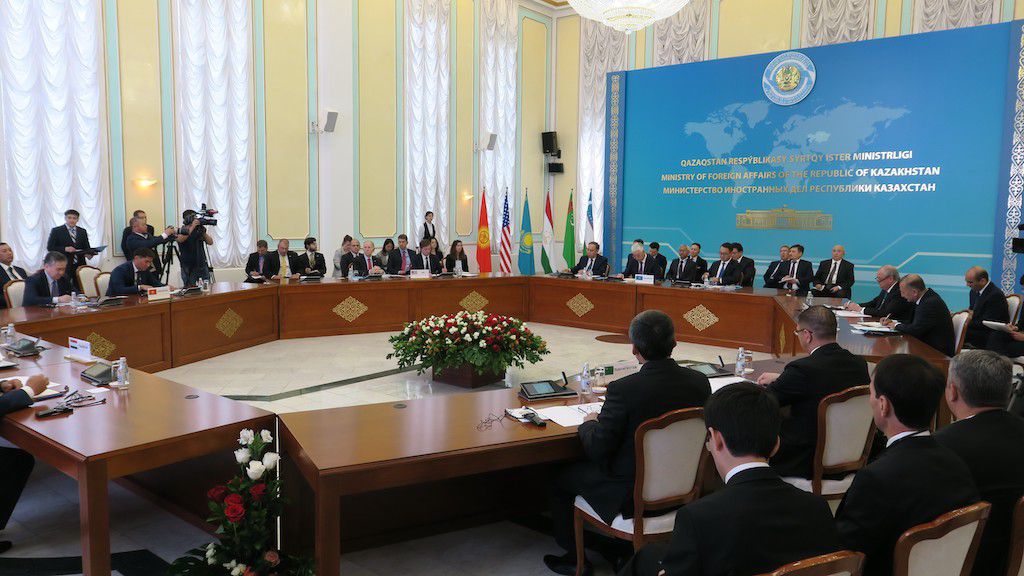The geopolitical rivalry in Central Asia will only intensify
The pandemic and economic slowdown have heralded a new era of rivalry in the geopolitics of Central Asia. While its old partnerships with Russia and China are on the wane, the region is turning towards new allies – and Washington may become one of them.

In a nutshell
- Central Asia is once again the arena for grand-scale geopolitical games
- Russia and China are the main powers vying for influence in the region
- Washington stands to intensify political and security relations with Central Asia
Situated at the strategic crossroads between Europe and Asia, Central Asia consists of five “stans,” formerly Soviet republics: Kazakhstan, Kyrgyzstan, Tajikistan, Turkmenistan, and Uzbekistan. The region’s geopolitical relevance has been steadily growing in the three decades of these nations’ independence since the breakup of the Soviet Union in 1991. It is bound to gain in importance even more in the years ahead.
Many of the frontline foreign policy challenges confronting today’s West, such as a resurgent Russia, an emboldened Iran and Islamist extremism, have converged in geopolitics in Central Asia. Its abundant hydrocarbons and mineral deposits add another level of strategic import to the area. Of late, an energy-thirsty and increasingly ambitious China has paved greater transactional inroads to the region, notably through expanding its Belt and Road Initiative (BRI). China has been in the top five trading partners of each of the countries, putting down an unambiguous marker of its geopolitical ambitions.
Facts & figures
Basic facts about Central Asia
Territory more than 4 million square kilometers
Population 73 million (2019)
GDP nominal $300 billion
GDP per capita $21,701 (2019; nominal)
$64,338 (2019; purchasing power parity)
Following more than a decade of rapid economic expansion driven by the hydrocarbon’s exports boom, the five culturally and ethnically diverse Central Asian countries must cope with falling commodity prices, reduced income from trade and lower remittances from expatriates.
Source: CIA, Bruegel
A new, more strategic game is underway on this evolving geopolitical chessboard that the Central Asian nations have been forced to navigate.
Geopolitics in Central Asia: Changing dynamics
Given the great powers’ clashing interests, the region’s governments perform high-wire balancing acts when dealing with Moscow, Beijing and Washington.
All Central Asian countries maintain a strong affinity with Russia. Nonetheless, China has been able to make visible and substantial commercial inroads into the region. Aggressively promoting bilateral trade and investment relationships with the region’s nations, Beijing, in many cases, unsettled and surpassed Russia’s influence. China’s transactional approach to economic relationships makes it a convenient partner to each country in the region, enabling a remarkable expansion in mutual exchange.
People in Central Asian countries have grown leery of China’s growing presence and begun to question the motivations behind Chinese investment.
However, there has also been uneasiness with China among the citizens and government officials in Central Asian countries. According to Eurasianet’s summary of a 2020 Central Asia Barometer survey, people in Central Asian countries have grown leery of China’s growing presence and begun to question the motivations behind Chinese investment in their countries.
- In Kazakhstan and Kyrgyzstan, distrust toward Chinese investors is already such that, respectively, only 7 percent and 9 percent of those polled in these nations voiced “strong support” for Chinese energy and infrastructure projects in their countries
- 75 percent of Kazakhs stated that they were “very concerned” by Chinese land purchases in their country
- In Uzbekistan, which does not directly border China, people tend to be more welcoming of Chinese investments than in the region’s other countries. Nonetheless, an increased degree of skepticism has been detected in Uzbekistan, too: while some 65 percent of Uzbeks expressed “strong support” for Chinese investments in 2019, less than 50 percent responded so in 2020.
- Equally notable is that in 2020, 53 percent of the Uzbek survey respondents answered that they were “very concerned” by Chinese land purchases in their country, up from 30 percent in 2019.
Much of the public in Central Asia no longer watch from the sidelines as Chinese capital, goods, workers and know-how are transforming the regional economic geography with the backing of the local governments. Looking ahead, it cannot be ruled out that some of the countries, especially Kazakhstan, Kyrgyzstan and Uzbekistan, could start rolling back China’s influence. Russia, which has long considered Central Asia its backyard, may also begin pushing back, eventually leading to friction with Beijing.
In this quickly evolving geopolitical setting, it is notable that leaders and governments in Central Asia, particularly Uzbekistan and Kazakhstan, have opened the doors for more significant interaction with Washington, signaling a possible new chapter in their bilateral engagements with the United States.
For example, Uzbekistan has been taking cautious steps toward modernizing its economic system and attracting more foreign investment. In 2018, its president paid a historic first visit to the White House, ushering in what the American side described as “a new era of strategic partnership” between the two countries.
Kazakhstan, Central Asia’s largest state by landmass and economic output, made strides in market reforms and has not been shy about its interest in becoming a strategic partner of the U.S. Also, it pushed back against both Russia and China on such issues as the former’s attempts to maintain its towering historical role in the region and the latter’s shackling investments.

Also notable is Kyrgyzstan’s ongoing transition despite lingering challenges. While experiencing spasms of civil unrest and political turbulence since 2010, Kyrgyzstan has managed to reach several significant milestones in its political development, such as holding presidential, parliamentary and local elections. On the economic policy front, the country remains relatively open to foreign direct investment, particularly from the U.S. and European countries.
In contrast to Uzbekistan, Kazakhstan and Kyrgyzstan, Central Asia’s other two “stans” – Tajikistan and Turkmenistan – have not opened economically to countries other than China. In the three decades since 1991, their authoritarian regimes have retained the closed economy model of the Soviet Union era.
Interlinked scenarios
Given the undercurrents steadily reshaping the geopolitics in Central Asia and its geostrategic settings and the jolts and dislocations caused by the global pandemic, what may lie ahead for the region? Arguably, some new openings for realignments in the geopolitics of Central Asia have emerged.
The region’s likely trajectory as a bloc will remain two-sided. Uzbekistan and Kazakhstan, and to a lesser degree Kyrgyzstan, will continue inching toward greater openness and engagement, although at a slow pace. As a whole, Central Asia will maintain its close trade and investment relationships with the European Union.
Notably, Kazakhstan, Kyrgyzstan and Tajikistan are already members of the World Trade Organisation (WTO), while the remaining two countries have not joined the trading block. Uzbekistan will likely continue to pursue its WTO membership with zest, but Turkmenistan’s outstanding accession bid seems half-hearted, and its prospects are uncertain.
Kyrgyzstan’s political instability is likely to linger.
Collective security issues and regional integration will continue to dominate discussions among the Central Asian countries. However, the divergence in the development paths between the two groups within the region – Uzbekistan, Kazakhstan, and Kyrgyzstan on the one hand, and Tajikistan and Turkmenistan on the other – is likely to grow.
In terms of country-specific scenarios, over the next year or so the geopolitics in Central Asia may evolve as follows:
- Uzbekistan will continue to balance its interests in the relations with its two main economic partners, Russia and China, while seeking greater interaction with the U.S. In 2020, it was one of the few countries in the world that avoided a coronavirus-induced economic recession. If this good luck holds, it stands a good chance to grow at a faster rate than other countries in the region
- Kazakhstan will likely preserve good relations with China, Russia, and the West. One of the continuing strategic policy priorities will be to sidestep disproportionate dependence on any single economic bloc by diversifying its trade and investment linkages. However, public discontent over China’s growing economic footprint in the country is only likely to grow
- Kyrgyzstan’s political instability (following from last year’s annulled parliamentary elections) is likely to linger despite the election of a new president and swearing in a new prime minister in January 2021. The government’s primary foreign policy challenge is maintaining its relationship with China in the face of high levels of outstanding debt to Chinese lenders. The country’s foreign debt is reportedly as high as $5 billion, with over 40 percent of that owed to the Export-Import Bank of China for financing a series of infrastructure projects over the last decade
- Tajikistan and Turkmenistan will see their economic reliance on China deepen further through borrowing and infrastructure investment. Ashgabat’s plan to increase natural gas exports to China, which already account for over 90 percent of Turkmenistan’s total exports, is likely to be delayed due to construction problems.
Outlook
Central Asia will remain principally an arena for competition between Russia and China. In the U.S., the skeptics of greater American engagement in the region have long argued that China and Russia are best left to continue their tug-of-war there. Yet Washington may discover that Central Asia has become too important for the U.S. to keep its distance.
The American superpower will not supplant Russia’s and China’s dominance in the region. However, the region’s largest economies will forge closer and more beneficial relationships with the U.S. through investment and trade. With their emphasis on balancing Moscow’s and Beijing’s influence, Kazakhstan and Uzbekistan will likely continue to seek and sustain political and security relations with Washington as well.








